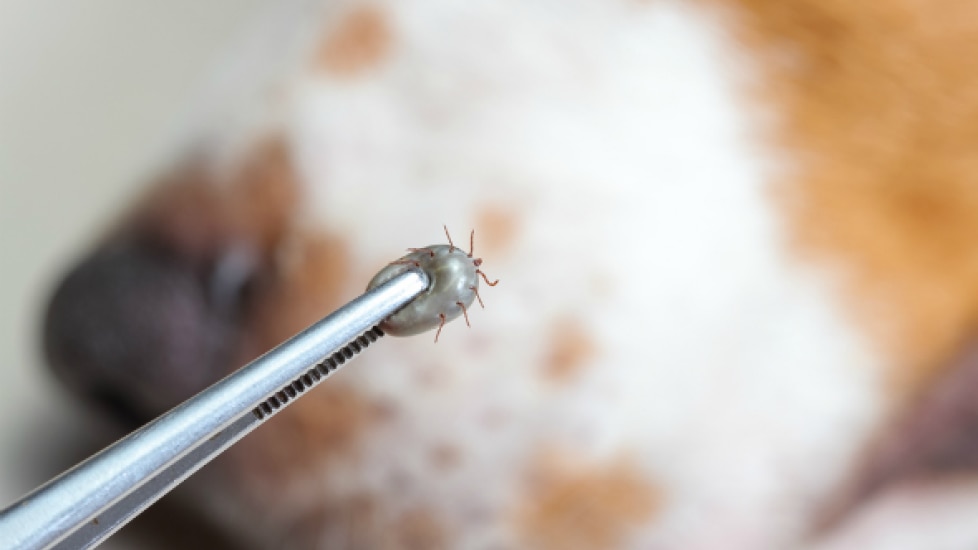Does My Dog Have Ticks?
How to Inspect and Remove Ticks from Your Dog
By Jennifer Kvamme, DVM
Some species of ticks can carry potentially fatal diseases that are transmitted when they bite your dog, and now is the time of year when some of them are most active and looking for hosts to feed from. To prevent the transmission of diseases, and to keep your dog more comfortable this summer, it's important to check your dog periodically for any unwanted parasitic hitchhikers before they can attach.
This is especially important to do after your dog has spent time outdoors in areas where ticks are likely to be present. Even if your dog wears a tick preventive collar or is given a spot-on medication, it’s a good idea to run a quick check during the summer months.
Doing a Thorough Body Check
So, how do you go about checking your dog over for ticks? Some dogs are easier to check than others. Longer hair coats tend to give ticks a better opportunity to hide deep in the fur where they can stay for a long time undiscovered, while shorter hair coats leave the surface of the skin more visible and easy to finger comb.
That said, ticks are a bit easier to spot on a dog’s body than smaller parasites; fleas, for example. They are usually dark and large enough to see easily (unless your dog’s hair is very long and/or full). Ticks do not move around much once they find a location on the body and bury their head into the skin to feed. The longer they feed, the larger their bodies become as they fill with blood.
Starting at the head, run your hands over the dog’s body, checking under the collar, and using your fingers like the teeth of a comb, thoroughly check all of the body, making sure to look under the tail and around the anus. Ticks are drawn to the dark, hidden areas on the body, so be sure to check between the toes, as well as inside the groin and front legs (armpits).
You are feeling for something about the size of a small pea. You may also want to use a brush or flea comb to check through the dog’s fur, stopping if you hit a bump or snag. Do not pull or force the comb over the bump, stop to see what the bump is before proceeding (pulling part of the tick’s body out can be damaging). You will also want to check the skin for areas that appear red or irritated, and watch your dog for any signs of excessive scratching or licking in any particular areas. This can be a sign that a tick has attached itself to the skin in this spot.
The ears are another particularly attractive area for ticks to lodge, as they are dark, moist, and hidden. Check the ears thoroughly, inside and out, during every inspection. If your dog is shaking his head continuously and you can’t see anything in the outer ear canal, your veterinarian can inspect the inner canal of the ear more closely with a special instrument (otoscope).
Vet Recommended Parasite Control
- Seresto Flea & Tick Collar for Dogs, over 18-lbs, 1 Collar (8-mos. supply)$47.98Chewy Price
- Capstar Flea Oral Treatment for Dogs, over 25 lbs, 6 Tablets$39.97Chewy Price
- Advantage Yard & Premise Spray, 32-fl oz hose-end spray$21.98Chewy Price
- Advantage Flea & Tick Treatment Shampoo for Dogs & Puppies, 12-fl oz bottle$19.48Chewy Price
Tick Removal and Disposal
Removal of any embedded ticks should be done carefully to be sure you get the entire tick out. You may wish to wear a pair of disposable gloves or use a paper towel when handling ticks. Using tweezers or a special tick removal tool you want to grip the tick by the head, as close to the skin as possible. Pull the tick straight out slowly and firmly without squeezing the body.
Do not twist the tweezers when pulling out the tick, do not try to burn the tick with matches, and do not apply anything to the animal’s skin to try to get the tick to “back out,” as these methods do not work.
After removing the tick, place the entire tick in a small amount of rubbing alcohol to kill it. Do not squash the tick with your fingers. The site where the tick was attached will leave a small wound. You may clean your dog’s skin with a disinfectant or apply a dab of triple antibiotic ointment once the tick has been removed, if you wish.




